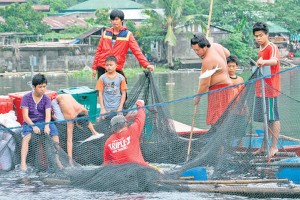Fishkill reported in 3 Batangas areas

ANOTHER FISHKILL Fishermen in Taal Lake race to harvest fish and minimize losses after low levels of oxygen were monitored in the fish cages off the waters of Talisay and Laurel towns in Batangas on Monday. Police put the latest fishkill at two tons. NIÑO JESUS ORBETA
SPO3 Larry Aala, team leader of the Philippine National Police Maritime Group in Batangas, said his men estimated the volume of the latest fish deaths at 2 tons in Barangay Sampaloc in Talisay town and 2 tons in Barangays Balakilong and Berinayan in Laurel town.
“We counted only a few sackfuls … this time,” Aala said, noting the hundreds of tons of fish that had died the previous weeks, and buried for safety reasons.
National officials have blamed the phenomenon on abnormal levels of dissolved oxygen (DO) in the lake due to overstocking by fish cage operators and weather changes. As a result, fish cage owners, including those operating illegally, suffered millions of pesos in losses as consumers shied away from buying their harvests.
On Saturday, Paz Manalang, acting regional head of the Bureau of Fisheries and Aquatic Resources (BFAR), said the DO level had stabilized and remained way below the limit set by the government.
The latest test conducted by the BFAR showed that the DO level in Sampaloc was 4.5 parts per million (ppm), or below the allowable level of 6 ppm, Manalang said. It was 3.8 ppm in Barangay Buso in Talisay and 4.9 in Barangay Banaga in Agoncillo town, she added.
Article continues after this advertisementIn a phone interview yesterday, Manalang said she had advised operators to tow their fish cages to areas where the DO level is acceptable and harvest their stocks. They should use pumps and engine sets lent to them to improve aeration in the lake waters, she said.
Article continues after this advertisementAala said fish that could not be harvested “were pulled to parts of the lake where there is sufficient oxygen.”
Some sections of Taal Lake have already shown signs of improved water quality, she said, but the BFAR official instructed the operators to wait until the entire lake had stabilized before restocking.
Manalang said the stability of the lake’s waters depended on favorable weather conditions, no “overturn” (mixing of cold and hot waters in the lake, causing sediments at the bottom to rise and drown the fish), and no deterioration of water quality.
On Wednesday last week, the DO level was 6.1 ppm in Barangay Quiling in Talisay, 6.14 ppm in Agoncillo, and 8.25 ppm in San Nicolas town—all above the normal level.
The readings were 2.73 ppm in Aya, Sampaloc and Tumaway, all in Talisay, and 5.14 ppm in Laurel
Ginette Segismundo, provincial information officer, said that in areas where the fish were half-dead (“hibay”), compressors to supply oxygen were provided.
As of June 17, she said, 281 of the 1,300 illegal fish cages in the Taal Lake had been dismantled. The figure included 29 in Laurel, 117 in Talisay, 69 in Agoncillo and 66 in San Nicolas.
There were no reports of anyone who have gotten ill after consuming fish recently harvested from the lake, Manalang said.
On Friday, officials and personnel from the Department of Environment and Natural Resources (DENR) met here on Friday and ate bangus and “tilapia” harvested from the lake to show that these were safe to consume.
Laudemir Salac, superintendent of the Protected Areas Management Board (PAMB) in the province and vice chair of the Task Force Taal Lake, said there was no need to embark on a massive information drive since residents and buyers were aware that the fishkill nightmare was over.
Salac said the dismantling of illegal fish cages had contributed to the positive DO level of lake waters due to the corresponding decrease in organic matter.
Oliver Morales, 39, a fish cage caretaker in Barangay Quiling, Talisay, said his sales of tilapia and bangus had increased since DENR and other government officials appeared on local television on Friday and ate fish from the lake.
He had been selling 50 kilos a day but after the fishkill, he could only manage 15-20 kilos.